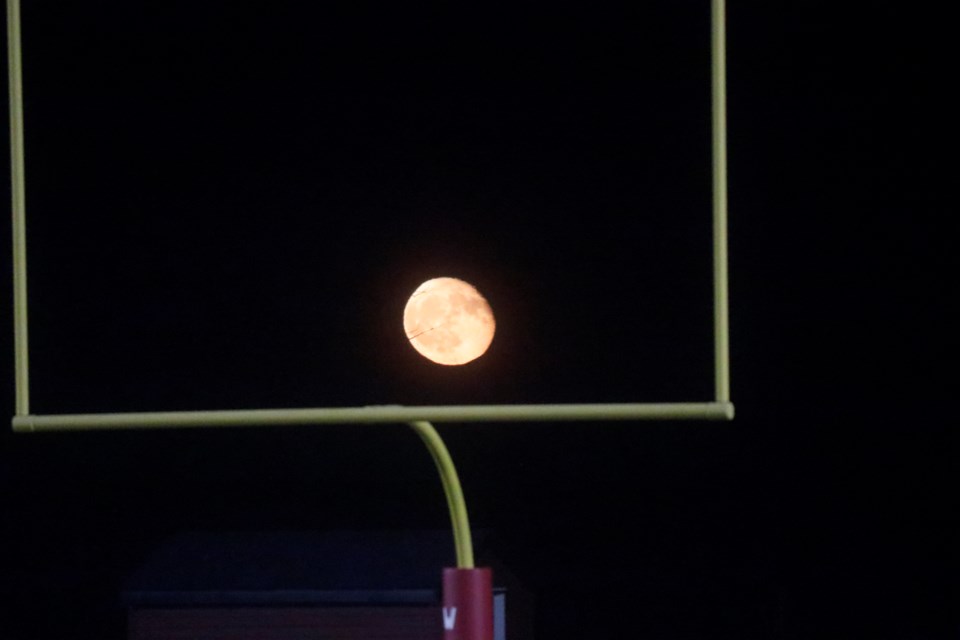The moon begins the month at new phase, also involved in an annular solar eclipse. The only land in position to see the eclipse is extreme southern Chile and Argentina, otherwise, the event is over the С����Ƶ Pacific. Eclipsophiles may charter a boat to get under the moon’s shadow. Annular eclipses become more and more frequent as the moon slowly moves away from Earth. Mark your calendars – in 50,000 years, there will be no more total solar eclipses.
Oct. 5, Venus is three degrees north of the waxing gibbous moon. Two days later, Oct. 7, Antares is 0.2 degrees north of the moon, an occultation in the С����Ƶern Hemisphere. By Oct. 14, the waxing gibbous moon nearly catches up to Saturn, only 0.1 degrees away in the early morning; this is an occultation for С����Ƶern Hemisphere viewers. A day later, also in the south, Neptune is occulted; only 0.6 degrees away from the north.
The moon is at perigee Oct. 16 (357,174 km) and full Oct. 17 – the largest of 2024, and generating large tides in coastal waters. Oct. 19, Uranus is four degrees south, and the Pleiades are even closer at 0.2 degrees south. Jupiter is six degrees south of the waning gibbous moon Oct. 21. Oct. 23, Pollux is 1.7 degrees north of the moon, while Mars is four degrees south. The bright star in Virgo, Spica, is 0.5 degrees south of the moon Oct. 31.
Mercury comes out from behind the sun toward the end of the month, but is a very difficult observation because the angle of the ecliptic is almost horizontal – the planet sets about the same time as the sun does.
Venus is bright in the western evening sky but hampered by the shallow ecliptic. The moon is nearby, but a very thin crescent Oct. 5.
Mars is high in the morning sky, as the ecliptic favours early risers. The Red Planet is among the stars of Gemini, The Twins, for most of the month, a little southwest of Pollux and Castor. An observer should be able to notice Mars getting brighter and larger with the passing weeks, as it appears to gradually near Earth. The closest approach is in early 2025.
Jupiter seems to stop moving eastward Oct. 9, beginning retrograde motion for about four months. The planet rises shortly after sundown and remains high in the sky all night, giving the best opportunity for viewing.
Saturn is up at sundown, crossing the sky all through the night among the stars of Aquarius – another great viewing time for the Ringed Planet. The moon glides by Oct. 14, getting up close to the gas giant – only 0.1 degrees away.
Uranus rises in early evening near the Pleiades, crossing the sky all night. This would be a good time to catch the blue-green planet without using optical aid. The waning gibbous moon passes by Oct. 18. Uranus is roughly three light-hours away – about three billion kilometres.
Neptune is in Pisces, The Fish. The planet is tiny, even in a telescope, given its great distance from us, over 30 astronomical units away. That’s 30 times our distance from the sun – Neptune is roughly 4.5 billion kilometres away – its reflected light takes a little over four hours to reach us.
The zodiacal light is visible before eastern morning twilight for the first two weeks of October.
The Orionid meteors peak Oct. 21.
James Edgar has had an interest in the night sky all his life. He joined the Royal Astronomical Society of Canada in 2000, was national president for two terms, is now the editor of the Observer’s Handbook and production manager of the bi-monthly RASC Journal. The IAU named asteroid 1995 XC5 “(22421) Jamesedgar” in his honour and in 2021 he was awarded a Fellowship of the RASC.




